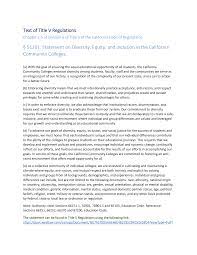Regular Effective Contact
Regulations
“Regular and substantive” (ACCJC) and/or “regular and effective” (Title 5) instructor-student interaction is required in all distance education courses. Research has shown that online courses with high levels of social interaction have a positive impact on learning.
Click the links below to familiarize yourself with regulations about regular effective contact in online courses. You will also find examples and practices for incorporating regular effective and/or substantive contact in your course.
Title 5
- Title 5, § 55204, Instructor Contact of California Education Code requires distance education courses to have “regular effective contact between instructor and students, and among students*.”
- *Please Note: In Spring 2019, Title 5 was amended to include the phrase “among students” to require student-student interaction in addition to instructor-student interaction. Review this resource to learn more about this update to Title 5.
ACCJC
- The Accrediting Commission for Community and Junior Colleges (ACCJC) requires distance education courses to have “regular and substantive interaction between the students and the instructor.” Read this article to learn more about four elements that guide regular and substantive interaction and this document for ACCJC’s guide for evaluating distance education.
Federal Regulations
- ACCJC’s definition of distance education above mirrors federal regulatory requirements.
ASCCC
- The Academic Senate for California Community Colleges (ASCCC) recommends that colleges develop regular and effective contact policies and adopted a paper providing guidance on professional standards for educational practices in online education.
The Peralta Community College District Distance Education Plan provides recommendations for acheiving instructor-student interaction that is “regular and substantive” (ACCJC) and/or “regular and effective” (Title 5). Based on an analysis of accreditation audits, WCET identified four criteria for what constitutes “regular and substantive interaction” (Poulin & Davis, 2016):
- Interaction must be initiated by the instructor. While this is not in the definition, it was highlighted in college audits by the Office of Inspector General.
- Interaction must be “regular” and …somewhat frequent. This is interpreted as repeated instances at specific intervals (e.g., once a week, twice a month) or conducted in the same way (via email, LMS announcements, LMS forums).
- Interaction must be “substantive” or of an academic nature. This is interpreted as activities that “further learning or assessment of learning”(Poulin & Davis, 2016, para. 22).
- Interaction must be with an instructor that meets accrediting agency standards.
Examples
Below you will find examples of instructor-student and student-student interaction. You do not need to incorporate all the examples below. They are intended as a suggested guide and may vary based on discipline, pedagogical approach, or instructional design:
- Welcome email or video
- Ideally a welcome email or video is emailed to students before the class begins to promote early engagement and set the tone for the course
- Some instructors send more than one pre-semester communication to create multiple touch points with students before the class begins
- First day or week of course check-in assignment
- Examples: a self- introduction discussion forum, syllabus or classroom code of conduct quiz, icebreaker activity, internet scavenger hunt, etc.
- A first day or week check-in assignment also helps determine online student attendance for census and attendance verification roster reporting
- Video conferencing via Zoom
- Examples: use for ongoing live office hours, exam review sessions, lectures, student oral presentations, student group projects, guest speakers, virtual field trips, etc.
- Customized front page
- Use a Front Page to post engaging content and important information about your course
- Some faculty update or modify aspects of their homepage weekly to coincide with the topic or unit in the course
- Use a Front Page to post engaging content and important information about your course
- Discussion boards
- Instructor moderated discussion forum assignments
- Equity Tip: Consider creating a system to track which students you respond to in the forum each week to ensure every student gets at least one response from you throughout the term. You can create an Excel spreadsheet to track responses or divide your roster into groups (i.e. alphabetical by last name– group #1 is A-F, group #2 is G-L, etc.) and respond to each group in intervals
- Q&A board where instructors or fellow students answer questions
- A student “chat cafe” or informal discussion board for students to connect with each other
- Instructor moderated discussion forum assignments
- Announcements
- Create regular written, audio, or video announcements in Canvas
- Can be used to preview, summarize, or clarify course content
- Post announcements with links to relevant articles or videos about course content
- Individual contact with students via e-mail, phone, or video
- Sign up for a free Google Voice phone number and forward calls to any phone number
- Sign up for a free Zoom account for video conferencing
- Consider responding to student emails/messages in Canvas with an audio or video comment to personalize the response
- Facilitating student to student contact
- Learn how to create groups in Canvas for small group projects, assignments, or presentations
- Create peer review assignments in Canvas
- Use Zoom to facilitate live group projects, study sessions, or presentations
- Use Canvas LTIs or apps to allow students to work and create connection with each other
- Timely and individualized feedback on student work
- Add text, video, audio, or speech recognition comments in SpeedGrader
- Add annotated comments using DocViewer in SpeedGrader
- Welcome email or video
Note: If you are using a publisher 3rd party website that only allows for automatically graded assignments, this should be supplemented with assignments in Canvas that allow you to give individualized, thorough feedback. When possible, course activity and interaction should be kept in Canvas for documentation.
Email Distance Education Coordinator Richard Kaeser at rkaeser@peralta.edu to add additional examples and best practices to this list.
CONTACT US
Technical Support
Submit a Peralta IT Ticket at https://helpdesk.peralta.edu
Canvas 24×7 Phone Support: (844) 592-2199
canvas@peralta.edu
helpdesk@peralta.edu


